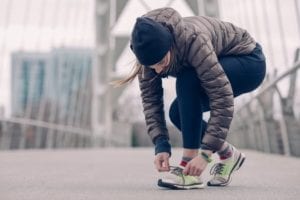Written by Greg Arnold, DC, CSCS. Twenty-four study participants, who took 300 mg of ashwagandha extract for 12 weeks, significantly improved cardiovascular endurance by 18.7% compared to the placebo group. They significantly improved Quality of Life scores as well.
 Ashwagandha, also known as Indian Winter Cherry, is an herb used extensively in Ayurvedic medicine. This is because of its role as “adaptogen” by helping the body adapt to stress, a property thought to be due to its’ antioxidants that also help maintain a healthy immune system 1,2. Ashwagandha’s ability to help increase feelings of vitality in its users have earned it the name “Indian Ginseng” 3,4.
Ashwagandha, also known as Indian Winter Cherry, is an herb used extensively in Ayurvedic medicine. This is because of its role as “adaptogen” by helping the body adapt to stress, a property thought to be due to its’ antioxidants that also help maintain a healthy immune system 1,2. Ashwagandha’s ability to help increase feelings of vitality in its users have earned it the name “Indian Ginseng” 3,4.
Now a new study 5 suggests that Ashwagandha may also improve endurance and quality of life in adults. The study involved 49 subjects (male/female breakdown not given) aged 25 to 49. They were given supplements with 300 milligrams of KSM-66 extract of Ashwagandha (24 subjects) or placebo (25 subjects) per day for 12 weeks. Before and after the study, each subject’s cardiorespiratory endurance was assessed by measuring the oxygen consumption at peak physical exertion (called “VO2 max” 6) during a 20-minute shuttle run test. They also completed The World Health Organization Quality of Life questionnaire.
After 12 weeks, those in the Ashwagandha group had a 13.6% increase in their VO2 max (41.74 to 47.41 Liters/minute) compared to a 4.4% increase in the placebo group (42.18 to 44.03 L/min) (p < 0.0001).
Those in the Ashwagandha group also had significant improvements in their Quality of Life:
- 14.7% increase in physical health (62.88 to 72.16) compared to a 4% decrease in the placebo group (58.88 to 56.58) (p < 0.0001)
- 19.6% increase in psychological health (63.28 to 75.72) compared to a 4% increase in the placebo group (60.71 to 63.17) (p = 0.0083)
- 21.6% increase in social relationships (60 to 72.96) compared to a 9.2% increase in the placebo group (57.79 to 63.12) (p = 0.0047)
- 9.7% increase in environmental health (65.52 to 71.88) compared to a 2.3% increase in the placebo group (58.79 to 60.17) (p = 0.0076)
For the researchers, “Ashwagandha” root extract improves the cardiovascular dynamics by increasing the VO2 max levels thereby enhancing the cardiorespiratory endurance, and also brings an improvement in QOL in healthy adults” but they admit that “due to the limited cross-section of the population considered in this study, the findings may not generalize to all populations” and that “further studies are needed to validate these findings.”
Source: Choudhary et al. Efficacy of Ashwagandha (Withania somnifera [L.] Dunal) in improving cardiorespiratory endurance in healthy athletic adults. Ayu. 2015 Jan-Mar; 36(1): 63–68. doi: 10.4103/0974-8520.169002
© AYU (An International Quarterly Journal of Research in Ayurveda)
Open access article under Creative Commons Attribution-NonCommercial-ShareAlike 3.0
Click here to read the full text study.
Posted August 18, 2016.
Greg Arnold is a Chiropractic Physician practicing in Hauppauge, NY. You can contact Dr. Arnold directly by emailing him at PitchingDoc@msn.com or visiting his web site at www.PitchingDoc.com.
References:
- Singh N, Nath R, Lata A, Singh S, Kohli R, Bhargava K. Withania somnifera (ashwagandha), a rejuvenating herbal drug which enhances survival during stress (an adaptogen). International journal of Crude drug research. 1982;20(1):29-35.
- Provino R. The role of adaptogens in stress management. Australian Journal of Medical Herbalism. 2010;22(2):41.
- Mishra L-C, Singh BB, Dagenais S. Scientific basis for the therapeutic use of Withania somnifera (ashwagandha): a review. Alternative medicine review. 2000;5(4):334-346.
- Weiner M. Herbs that Heal Mill Valley, CA: Quantum Books; 1994.
- Choudhary B, Shetty A, Langade DG. Efficacy of Ashwagandha (Withania somnifera [L.] Dunal) in improving cardiorespiratory endurance in healthy athletic adults. Ayu. 2015;36(1):63.
- Leger LA, Lambert J. A maximal multistage 20-m shuttle run test to predict VO2 max. European journal of applied physiology and occupational physiology. 1982;49(1):1-12.
